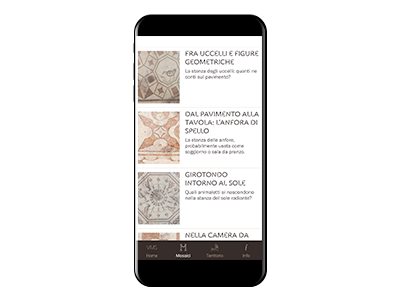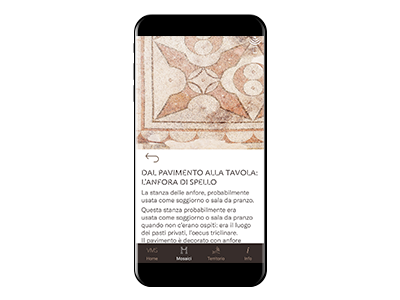Interactive app
The virtual Villa on your phone
We’ll be waiting for you at the Villa to complete your experience!
APP UNDER UPDATE

Automatic updates

Offline navigation

Interactive datasheets

The App allows you to view the Villa's contents, history and curiosities, complete with with photographs, videos and details.

Thanks to the Beacons with bluetooth technology, once you're inside the Villa, all you have to do is approach a room or a display case to view information and photos directly in the App.

Listen to the audio guide to find out more about the room you’re looking at. Make the most of your museum experience.
Integrated with the museum
The Museum is equipped with sensors (Beacons) next to the most important rooms. The sensors are detected by our App, and the appropriate screens will be displayed when you approach them. This allows you to learn more about what you’re seeing, with historical information, detailed photographs, and a helpful audio guide.
Multimedia stations
Interact with our digital stations in the multimedia room, and discover how the Romans lived during the Imperial age.

Interact with the tablets

Learn about the lifestyles of the ancient Romans

Find out more about what interests you
Get a sneak peek at some of the content
The Latin term used by ancient writers to indicate private buildings built outside of town was villa, a word that has a wide range of meanings: for the Romans, villae included farms used exclusively for agricultural production, which they referred to as rusticae, as well as luxurious residences intended for relaxation, known as villae d'otium. Between these two extremes, there were also intermediate types: agricultural villas also equipped for temporary stays, and luxury villas comprising areas designed for specialised crops. Starting in the 2nd century B.C., prestigious villas were even constructed within or in the immediate vicinity of the towns: these were known as urbanae, and were often surrounded by gardens. Villae rusticae were generally farms outfitted for agricultural production, with a slave workforce. The villae d'otium had layouts inspired by the Greek models.
The dining room is called the triclinium, meaning the room with three couches. The couches were arranged in a U-shape around a central table, and each could accommodate three diners. In Rome, adult men ate lying down, resting on their left elbow, next to one another, with their heads facing the table. When permitted to attend meals, the women and children remained seated. The Atrium and the dining rooms were the most luxurious environments: in fact, banquets were held in the places where friends were welcomed, in a social environment that was open to the outside through the sharing of intimacy. Sometimes there were even two dining rooms, a smaller one at the back of the house, where private meals could be enjoyed by the family, and another more luxurious one at the front, which was used for receptions.
The rooms of the more affluent homes were only luxuriously furnished starting in the Hellenistic age (323 B.C. to 31 B.C.). Paintings, sculptures, tapestries, wall decorations in paint and stucco, ornate wooden and painted ceilings, and mosaic floors all gave strong chromatic accents to the environments. The rooms contained wall cabinets, beds, marble tables, and sliding partitions or transennas.
The furniture was arranged according to specific patterns: the tables, whether fixed or mobile, stood at the centre of the rooms, while the other furniture and statues were placed along the walls. The most important element was the bed, which was used for sleeping, eating, and working.
There were various types of chairs: the seat of the dominus (solium), the throne with an arched back (cathedra), specifically for the women, and stools (scamna or subsellia). The typical Roman cabinets (armaria), which were made of wood and inlaid with ivory, ebony, gold, silver and even turtle, were used to store rolls of books, supplies and tableware; clothing, on the other hand, was stored in trunks.

